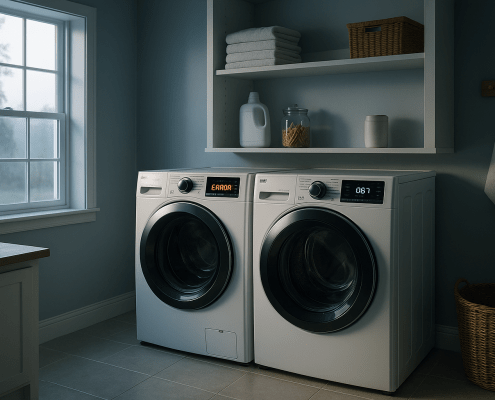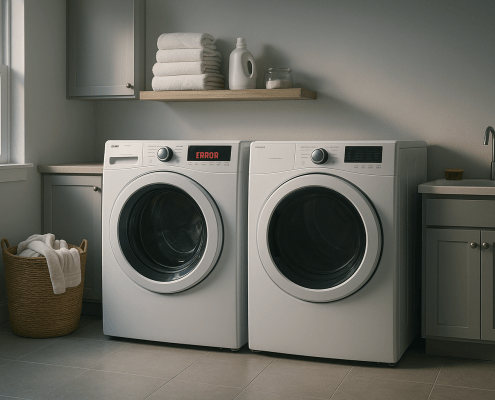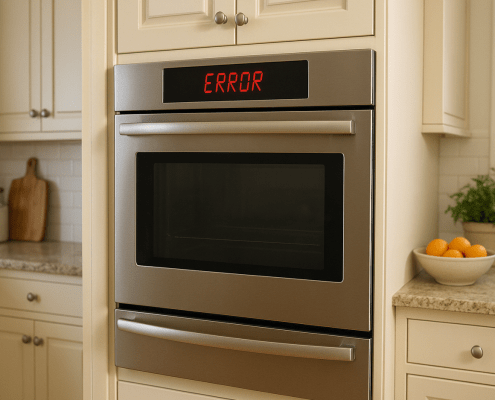What LG Washer Error Code PF Means and How to Fix It
Steven E / Thursday May 8, 2025
Started a load of laundry only to come back and find your LG washer flashing a mysterious PF code? Don’t worry, it’s not as scary as it looks. That little code just means there was a power failure, and your washer didn’t get to finish what it started. We’ll walk you through exactly what causes the PF error, how to fix it fast, and how to keep it from happening again. Let’s get that laundry back on track!
If you find out that you need any replacement parts for your appliance while you’re troubleshooting, you can enter your model number at AppliancePartsPros.com to order them. Most orders arrive in just two business days, and we have thousands of free guides to show you how to install your new parts.
The information in this article may not apply to your specific appliance model. We recommend consulting your manufacturer’s documentation or contact us with any questions.
Common causes of the error
A variety of factors can cause the PF code, making it crucial for users to understand these causes. This understanding enables them to apply effective troubleshooting techniques to fix the issues. Here are the most common reasons behind this issue:
- This is one of the most prevalent reasons behind the PF error code. If there’s a sudden loss or disruption in the power supply during the washing cycle, it triggers the appearance of this code.
- Issues with electrical connections can result in the display of a PF error code. It’s necessary to make sure that your LG washer is connected properly to a reliable power source.
- If the voltage drops below a certain threshold, LG washers detect this as a power failure and manifest it as a PF error.
- Much like power outages and voltage drops, a sudden power surge of electricity through your home wiring system can trigger a PF error code on your washing machine’s control panel.
Washer repair safety
When working on any appliance, remember to keep safety first. Here are some tips to keep in mind:
- Always power off and unplug your appliance or switch off the circuit breaker before attempting any maintenance or replacement work. This keeps you safe by preventing any risk of injury from electric shock.
- Wear insulated work gloves to protect your hands from sharp metal parts, pinching hazards and debris.
- Take your time and don’t rush while working to prevent accidents and personal injuries.
- Work in a well-lit area so you can clearly see and access the interior parts.
- Clear your workspace of clutter and other obstacles. Keep children and pets away from the work area.
- Never work on internal parts with bare wet hands. Make sure the work area is completely dry.
- Check your user manual to see if there are specific installation or safety instructions for your part or appliance.
- Be gentle when handling or removing parts. Excessive force might damage the appliance or cause injury.
- Wear safety glasses when working with chemicals, dust or cleaning large debris to prevent injury.
- If the appliance has recently been used, give it plenty of time for any heating parts to cool down before working on it.
- Take pictures or make a note of wiring terminals or other connections before disconnecting to prevent any problems with reassembly.
- When working with wires, avoid touching any exposed wires or terminals. If you need to touch a wire, use a non-conductive tool or wear insulating gloves to prevent electrical shock.
Troubleshooting steps
Step 1: Check the power connection
Ensuring that the LG washing machine is receiving adequate power is a pivotal step in rectifying the “PF” error code. Here’s what to do:
- Begin by examining the power cord for signs of damage or wear. This includes fraying, cuts, or any other noticeable physical defects.
- Next, confirm that the power cord is securely plugged into an operative electrical outlet. A loose connection can often cause a sporadic power supply leading to the PF error on your LG washer.
- Verify whether the outlet provides a suitable voltage for your machine’s requirements. A multimeter can be used to measure this accurately.
- Check for blown fuses or tripped circuit breakers in your home’s electric panel which could disrupt the power supply to your washing machine.
- If your washer is connected through extension cords or multi-plug adaptors, try connecting it directly to a wall socket instead for optimal electricity supply.
Step 2: Confirming proper voltage supply
To troubleshoot the ‘PF’ error code on your LG washer, it is crucial to confirm that the voltage supply to the machine is proper. Here are some steps to help you ensure a correct voltage supply:
- Make sure the power cord is securely plugged into both the wall outlet and the back of the washing machine. Inspect for any visible damage or frayed wires that may affect the power connection.
- If you suspect an issue with the outlet itself, try plugging in another appliance to see if it works properly. If not, there may be a problem with the electrical circuit or outlet that needs to be addressed by a professional electrician.
- Avoid using extension cords or sharing power outlets with other high-power-consuming devices. Connect your LG washer directly to its dedicated electrical circuit and ensure it has its own separate power line.
- Voltage drops or surges can disrupt the operation of your washer and trigger the ‘PF’ error code. Consider installing a voltage stabilizer or surge protector to regulate and protect your washer from fluctuations in electricity supply.
Step 3: Inspect for loose wiring
Loose wiring can disrupt the power supply and cause the machine to display the PF error message. Here’s what you need to do:
- Before inspecting for loose wiring, always unplug the washer from the power source to ensure your safety.
- To access the wiring inside the washing machine, remove the back panel carefully. Refer to your user manual for specific instructions on how to do this for your LG washer model.
- Take a close look at all wire connections, including those connected to the control board, heating element, motor, and other components of your LG washer. Look for any visibly loose or disconnected wires.
- If you find any loose or disconnected wires during your inspection, gently reconnect them securely. Ensure that each wire is properly inserted into its respective connection point.
- Along with individual wire connections, check that all wire harnesses (bundles of wires) are securely fastened in place and not loose or hanging freely.
- Once you have inspected and secured all wiring connections, reassemble the back panel of your LG washer and plug it back into the power source. Run a test cycle to see if the PF error code persists.
Step 4: Test the control board
The control board is the control module responsible for managing the power supply and other functions of the washer. By testing the control board, you can determine if it is functioning properly or if it needs to be replaced. Here’s how you can test the control board:
- Disconnect the power: Before performing any tests, make sure to disconnect the power to the washing machine. This will ensure your safety during the testing process.
- Inspect for visual damage: Carefully examine the control board for any signs of visible damage such as burnt marks, loose connections, or blown capacitors. If any components appear damaged, they may need to be replaced.
- Test with a multimeter: Using a multimeter set to measure voltage or resistance, test various points on the control board to check if there is continuity and proper voltage supply. Referencing the manufacturer’s manual will help you identify which points to test and what readings are expected.
- Compare readings with specifications: Compare your readings with the specifications provided in the manufacturer’s manual or technical documentation for your specific LG washer model. If there are significant deviations from these specifications, it may indicate a problem with the control board.
Additional information
Thank you for reading! We hope you found this information useful to get your washer working again.
If you have any other appliance repair needs or projects, don’t hesitate to explore our thousands of free videos and troubleshooting guides available. If you need replacement parts or some extra help, grab your model number and head over to AppliancePartsPros.com, where you can chat with a pro, order parts, read our DIY blog, and more.
Be sure to subscribe to us on YouTube and follow us on Facebook, Twitter, and Instagram!
With nearly a decade of experience in providing top-notch customer service regarding appliance parts and repair, Steven enjoys sharing practical advice, troubleshooting tips, and interesting information to help readers stay informed.





